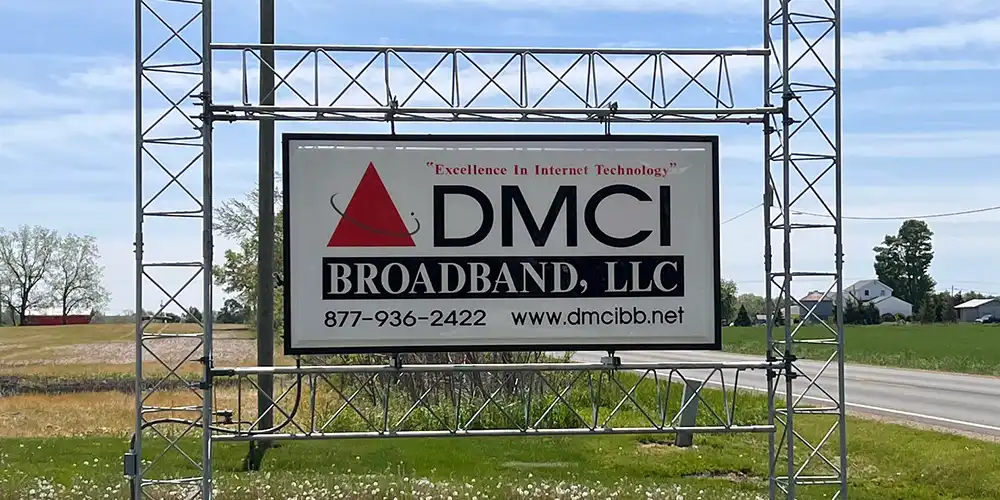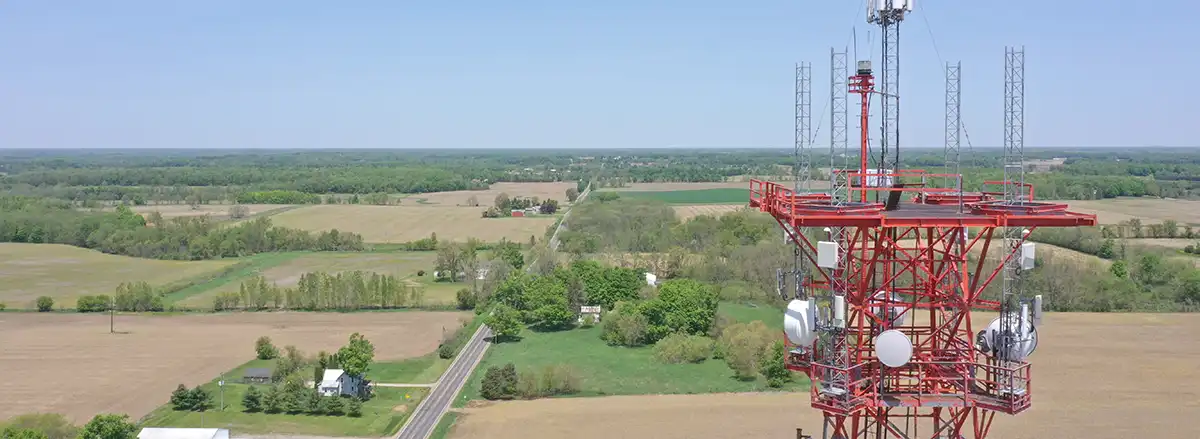Fiber FAQ
Fiber optic internet is a type of internet connection that utilizes fiber optic cables to transmit data at high speeds. It is considered one of the fastest and most reliable internet technologies available today.
Fiber optic internet is a technology that relies on the transmission of data using pulses of light.
This light travels through extremely thin strands of glass or plastic called optical fibers. These fibers have a core, which is where the light travels, and a cladding layer that surrounds the core and helps keep the light contained within the fiber.
Into the cable
When data is sent over fiber optic internet, it is first converted into digital signals. These signals represent the information, such as text, images, videos, or any other type of digital content. The digital signals are then transformed into light signals, which are made up of rapid pulses of light. The light signals are injected into the core of the optical fibers, where they begin their journey.
Down the road
As the light travels through the fiber, it undergoes a process called total internal reflection. This means that each pulse of light hits the boundary between the core and the cladding layer at such an angle that it reflects back into the core instead of escaping. This reflection allows the light to bounce along the fiber, traveling long distances without significant loss of signal strength. Because the fibers are incredibly thin, multiple optical fibers are often bundled together within a protective outer coating to form a fiber optic cable. These cables can contain hundreds or even thousands of individual fibers, enabling the transmission of a vast amount of information simultaneously.
Arriving
At the receiving end of the fiber optic connection, there is an optical receiver. This device detects the light signals as they exit the fiber optic cable. It then converts the light signals back into electrical signals, which can be understood and processed by computers, smartphones, or other devices. The electrical signals are then further processed and decoded to retrieve the original digital data. For example, if it was a video being transmitted, the electrical signals would be converted back into the visual and audio components of the video, allowing you to watch it on your screen.
A typical fiber optic internet system consists of three main components:
Optical Transmitter: The optical transmitter is responsible for converting electrical signals into optical signals that can travel through the fiber optic cables. It typically uses a laser diode or Light Emitting Diode (LED) to generate the light pulses representing the data. The transmitter also performs modulation, encoding the data onto the light signal for transmission.
Optical Fiber: The optical fiber is a thin, flexible strand made of glass or plastic. It serves as the medium through which the optical signals travel. Fiber optic cables usually consist of multiple fibers bundled together within a protective outer coating. Each fiber can carry a large amount of data simultaneously by transmitting light signals through total internal reflection. The fiber's core, which carries the light signals, is surrounded by a cladding layer that reflects the light back into the core, preventing signal loss.
Optical Receiver: The optical receiver is located at the receiving end of the fiber optic connection. Its primary function is to detect and convert the incoming optical signals back into electrical signals that can be understood by the connected devices. The receiver uses a light-sensitive component, such as a photodiode, to receive the light pulses and convert them into electrical current. The electrical signals are then processed, amplified, and decoded for use by computers, routers, or other devices.
Fiber optic internet offers several advantages over other types of internet connections:
High Speeds: Fiber optic internet offers significantly faster speeds compared to traditional copper-based connections like DSL or cable. It can provide speeds ranging from hundreds of megabits per second (Mbps) to gigabits per second (Gbps). This allows for quick downloads, seamless streaming of high-definition content, and smooth online gaming experiences.
Reliability: Fiber optic cables are highly resistant to external interference such as electromagnetic radiation, radio frequency interference, and cross-talk from nearby cables. They are also less affected by environmental factors like extreme weather conditions, making fiber optic internet more reliable with minimal disruptions in service.
Symmetrical Speeds: Unlike some other internet technologies that offer asymmetrical speeds (higher download speeds but lower upload speeds), fiber optic internet can provide symmetrical speeds. This means that the upload speeds are just as fast as the download speeds. Symmetrical speeds are beneficial for activities that require a high upload capacity, such as video conferencing, cloud computing, and uploading large files.
Signal Quality: Fiber optic cables can transmit data over long distances without significant signal degradation. Unlike copper cables, which may experience signal loss or degradation over longer distances, fiber optic signals can travel for several kilometers with minimal loss, maintaining high-quality and consistent data transmission.
Security: Fiber optic internet is highly secure due to its unique properties. Since light signals are used for data transmission, it is difficult to tap into the fiber optic cables and intercept the data. Additionally, fiber optic cables do not emit electromagnetic signals that can be easily intercepted or hacked, providing an added layer of security for sensitive data.
Fiber optic internet is compatible with most existing devices that connect to the internet. Whether you have a computer, smartphone, tablet, smart TV, or other internet-enabled devices, you can use them with fiber optic internet.
Wired Devices:If your existing devices have Ethernet ports, you can directly connect them to the fiber optic internet connection using Ethernet cables. Many devices, such as desktop computers, gaming consoles, and smart TVs, have Ethernet ports built-in. Simply connect one end of the Ethernet cable to the Ethernet port on your device and the other end to the Ethernet port on the Optical Network Terminal (ONT) or router.
Wireless Devices: Fiber optic internet also supports Wi-Fi connectivity, allowing you to connect wireless devices to the network. Most modern smartphones, tablets, laptops, and smart home devices have Wi-Fi capabilities. To connect wirelessly, ensure that your Wi-Fi router or access point is properly configured and broadcasting the Wi-Fi network. Then, you can connect your wireless devices to the network by selecting the appropriate Wi-Fi network name (SSID) and entering the password (if applicable).
Modems and Routers: In most cases, you will need to replace your existing network equipment to fully utilize fiber optic internet. Fiber optic connections require specific equipment, such as an Optical Network Terminal (ONT), which converts the optical signals into electrical signals for your devices. Additionally, you may need a router that supports fiber optic connections and can handle the high speeds provided by the internet service.
Fiber is one of the fastest internet technologies currently available.
Gigabit Speeds: Fiber optic internet can commonly deliver speeds in the range of gigabits per second (Gbps). This means that data can be transmitted at rates of 1,000 megabits per second (Mbps) or higher. Gigabit internet connections have become increasingly popular in homes and businesses, enabling lightning-fast downloads, seamless streaming of high-definition content, and smooth online gaming experiences.
Upstream and Downstream Speed Parity: One of the notable advantages of fiber optic internet is its ability to provide symmetrical speeds. Unlike some other internet technologies, which offer faster download speeds but slower upload speeds, fiber optic internet can provide equal speeds for both upstream (upload) and downstream (download) data. This makes it ideal for activities such as video conferencing, cloud storage, and uploading large files, where fast upload speeds are crucial.
Scalability for Higher Speeds: Fiber optic infrastructure has the capacity for future speed upgrades. While current fiber optic plans often offer speeds in the range of hundreds of megabits or gigabits per second, advancements in technology and network upgrades can enable even faster speeds in the future. This scalability allows fiber optic internet to keep up with the growing demands of data-intensive applications and evolving technology.
Consistency over Distance: Unlike copper-based connections, fiber optic internet maintains its high speeds consistently over long distances. With traditional copper cables, the speed and quality of the connection tend to degrade as the distance from the exchange or central office increases. Fiber optic cables, on the other hand, can transmit data without significant signal loss or degradation over much longer distances, making it suitable for both urban and rural areas.
Lower Latency: In addition to high speeds, fiber optic internet also offers low latency, which refers to the delay or lag in transmitting data. Fiber optic connections have significantly lower latency compared to other internet technologies. This low latency is crucial for real-time applications such as online gaming, video conferencing, and voice over IP (VoIP) calls, where even minimal delays can impact the user experience.




